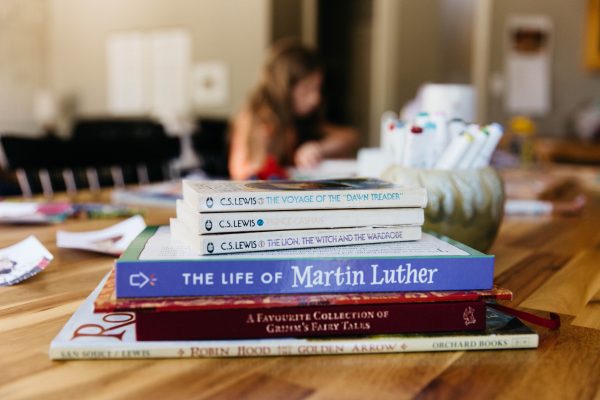Are you shopping for homeschool curriculum? Are you feeling the rush of magic and wonder? I love those mid summer Amazon packages of possibility on my door step!
All of us have had an experienced homeschooler or two tell us to just relax on curriculum. Well, thank you for that, but what does that even mean?
Like, what’s the actual difference between relaxing and gross negligence?
That’s where a few easy curriculum hacks can help you out.
But first, I want to establish something important: when you buy curriculum, you are buying a tool box, not a checklist. Curriculum creators purposely pack curriculum full of content with the understanding that you will not do all of it. They assume you’ll use what you need and leave the rest.
I also want to reassure you that legal requirements don’t dictate exactly how you use curriculum either. Most states, with the exception of a few, aren’t checking what level you’re in, when you do your work, or how far you get. In most cases there are no official agents that are going to come knocking on your door because you didn’t finish the curriculum!
There is a very real pressure that comes along with the financial and emotional investment of purchasing curriculum. Our investment tends to influence whether or not we feel like we can leave parts behind. A lot of times we don’t feel like we can because we spent so much money and research time getting it right.
Let’s talk about that!

Here are a few of my favorite techniques for hacking homeschool curriculum:
The Pick-Up
Having lessons pre-organized by week or day is really nice, and it’s a totally rational way to organize lessons (I mean, I would if I were creating a curriculum!) But it doesn’t mean that anyone expects you to have to do it that exact way.
The pick-up is as easy as it sounds: do a little bit each day and then pick up where you left off. For example, sometimes a math lesson is slated to last one day according to the curriculum schedule. But maybe we actually need three days to internalize the concept and another week to practice it.
In these cases, we just pick up wherever we left off last time.
You can also do this on a yearly basis. Let’s say you broke for summer without finishing a curriculum, but you really wanted to. No problem, just pick it back up in the fall when you’re back on a routine.
This is nice for people who feel invested in curriculum and really want to finish but don’t want the pressure of the timetable.

The Menu
My favorite way to use curriculum is to pick from it like a menu. Over the years we have used a literature-based curriculum to cover our literature, history, science and geography. (This just means we read from whole books, not textbooks or scripts.)
Part of our curriculum contains a weekly grid with suggested activities that go along with each weeks’ theme: timeline cards, narration suggestions, baking projects, and other hands-on activities.
Oh, man, I want to do each and everyone one of these ideas! But instead of over scheduling or getting overwhelmed, I do something else: I treat it like a menu. When I’m gathering our books for the week, I’ll sit down and say “Hmmmm…what sounds good?” I’ll take a highlighter or marker and circle whatever seems appealing. I know that my sweet spot is usually about one hands-on activity a week.
Need more time to plan ahead? You can also use the same technique but do it on a monthly basis.
I really like this because I feel like I still get the value out of my curriculum without feeling burdened down.

The Segment
This is where I’ll intentionally select a segment of the curriculum and only use that portion through the year. You can segment by content or by timeline.
For example, one year I used a first grade book list from Sonlight for the main part of our homeschool. I loved their book selection, but I didn’t want to do the worksheets and science projects, so I only used the books. In this case, I used a segment of the content that I wanted. (P.S. you can get the book list to every level on their website for free!)
Another year we did a lovely year-round nature study curriculum. Except we only did the lessons in the fall and spring months when the weather was nicest. In this situation, I used a segment of the timeline that I wanted.
This works best with less expensive, used, or free curriculum where you don’t waste money on materials you don’t plan to use.
The Combo
This is one of the biggest secrets to homeschooling multiple children at once: you can use the same level of curriculum for multiple kids. This works really well with topical subjects like science, history, and literature because there really is no need to do any of these in linear order. I promise you, it really, really does not matter whether you start with European history or world cultures.
In the case that there is a minor difference, one rule of thumb is always to “teach up.” You can do this by choosing a curriculum that is more advanced and most fitting to the oldest children in the group. The younger children will absorb what they can–and trust me, they will surprise you with what they get! Everyone will engage and express at the level of their ability.
I do this by purchasing either a family-centered, literature-based curriculum (purposely designed for multiple ages) or by choosing a leveled literature-based curriculum appropriate to the oldest child in the group.
Here’s another surprise: you can also do this with other leveled material like math and phonics! One of the downsides to homeschooling multiple kids is that you have more than one child to help at once. They are usually close in age and they need your attention and time all at the same time. (Ahhhh!). Sometimes if you have kids close in age, you can put them in the same leveled material. We did this for a few years until my girls started branching off at different paces.

I know it feels overwhelming with multiple kids, but the reliant-on-mom-for-school season is temporary.
Are you feeling a little more free yet? As you research and purchase your homeschool curriculum this year, I want you to remember that you are not buying a rigid checklist, but a tool box full of options and possibilities. Use these hacks to create a custom plan for the ages and personalities in your family!
For a full, curated list of our curriculum favorites go here! By the way, if you’re on a budget this blog post has a list of the exact curriculum I’d set you up with to get the most bang for your buck.
If you’re looking for our top, must-have homeschooling supplies (we’re minimalists), you can find our favorite homeschooling essentials here in our Amazon shop.
For candid thoughts on faith, motherhood and homeschooling, subscribe to my Substack newsletter!